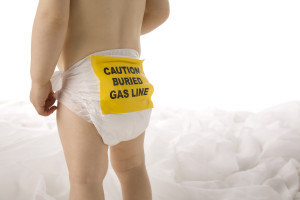
Many babies seem to be disturbed by abdominal gas; they either ingest bubbles of air while feeding or gas forms in the gut as bacteria breaks down undigested sugars. When this problem is really bad it is usually called colic. Two things can contribute to the problem of gas – fast feeding and failure to burp halfway between the feed and after completion.
If a baby who is bottle-fed is troubled by gas, you can try using a teat with a smaller hole in it to reduce the speed of feeding. Gulping formula down will often be a major cause of gas. But leaving baby until he is actually crying with hunger can also cause it. A hungry baby will suck fast and if the teat holes are too small will not get enough milk quickly enough to satisfy it. The baby will then pull away from the teat and continue crying.
So feeding your baby before he or she gets to that frantically hungry stage will help the problem of gas. Adequate burping when the baby has had half the feed will also help. Sit the baby up on your knee and gently pat its back, until a burp comes forth. Holding the infant against your shoulder and rubbing the back is another time-honoured way of burping baby to expel baby gas.
Strong and hungry babies may object strenuously to being removed from their source of food supply. If gas is not too much a problem, then allowing them to finish the feed without interruption is better than having a lot of fuss until they get that teat back.
There are other natural means of removing gas – or rather, helping gas to remove naturally. If a baby seems uncomfortable after a feed and cries a lot, pushing the knees up towards the stomach either both together or as in ‘riding a bicycle’ may help.
Gently massaging the abdomen in a clockwise direction may also help, as may extra warmth, such as with a warmed wheat pillow. Just make sure it is not too warm. However, if the baby has colic, then you may need to give relief with appropriate medication. Depending on what it is, this may be added to the bottle, given before a feed with an eyedropper or given after the feed.
A breast-fed baby can also suffer from gas – generally from the same reasons. That is, ingesting too much air while feeding or failure to burp. Reducing the flow of milk can be achieved by reclining while feeding. It may also help to lay right down flat and let the baby feed either by lying on its stomach across your abdomen or in a half-kneeling position against your side.
A breast-fed baby can be difficult to remove from the breast without pain and so burping is left until the feed is over – maybe causing gas build-up. To break the suction without pain, simply press your finger gently against the corner of baby’s mouth until there is a little gap. You’ll then be able to slide the nipple out quickly before another suck is taken.